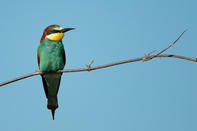
Name
European bee-eater (Merops apiaster)Appearance
The European bee-eater is the most colourful of the bee-eaters, with a yellow throat, black gorget and a brown/chestnut and yellow back. The underparts of this bird are a turquoise colour. This bee-eater can reach a length of 25 cm, including the 2 elongated feathers in the centre of the tail.Diet
The European bee-eater hunts insects that are in flight. Once they catch an insect, they will return to a perch to kill the insect and remove its sting, by repeatedly hitting the insect against the branch. The European bee-eaters preferred insects are bees, wasps and flying ants. They have been recorded eating over 200 insects in a single day.European Bee-eater Breeding
The European bee-eater does not breed in South Africa, which breeds in Southern Europe, parts of North Africa and Western Asia.The European bee-eater is monogamous and breeds in large colonies. They tunnel into river banks and nest at the end of the tunnel. Both male and female will brood the eggs.
European Bee-eater Behaviour
The European bee-eaters found in South Africa are non-breeding Palearctic or intra-African migrants. A palearctic migrant is a bird that migrates from a region that includes Europe, northern Asia, eastern Siberia and North Africa and an intra-African migrant is a bird that migrates only within the continent of Africa.
The European bee-eater arrives in South Africa around October and departs around April, spending the northern hemisphere winter in South Africa. This bee-eater is very gregarious and is seen in flocks of up to 100 birds. When hunting, this bird prefers to hunt on the wing and will very rarely hunt from a perch.